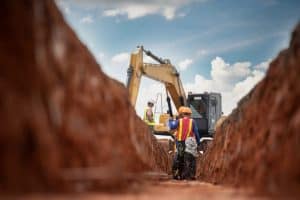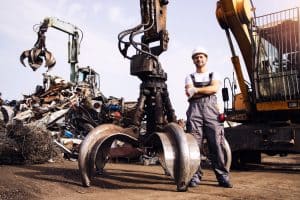Pedestrians and Vehicle interaction:

Forklifts and pedestrians must share the working spaces within the typical warehouse/logistics environment.
Many of these workplaces have blind spots, obstacles, and poor visibility. In addition to these environmental factors, human factors increase risk of accidents (inattention, blind spots and ignoring safety directives from management).
Initiatives like painted lines and verbal direction to stay a safe distance from vehicles can be ineffective. Invariably someone does the wrong thing at the wrong time and an incident occurs.
Several of the current electronic control solutions are not effective because they require line of sight to work properly. Those systems cannot respond until it is too late to act (a person has just walked around a blind corner or out of an aisle without looking). People can also be out of sight due to smoke, dust, water, or stacks of pellets.
This is where the power of a real-time detection and warning system, that can detect personnel in these situations, comes into its own.
Keeping pedestrian staff safe:

Keep pedestrian workers safe from injury or death
The BodyGuard Pedestrian Safety System has been designed to focus on performance, reliability, and simplicity. The system provides an effective solution for mitigating risk of pedestrian staff being injured or killed by pedestrian and mobile plant interaction. BodyGuard Safety Solutions have been careful to maintain this focus on the primary task of detection and warning to save lives and not cluttered with “bells and whistles” that might appear to be nice to have but detract from the prime purpose of the system.
Active detection system:

The BodyGuard Pedestrian Safety system is an active detection system that implements small electronic Tag devices (worn by pedestrians) to determine when a pedestrian has breached the safety exclusion zone. Being an active system, this overcomes issues of system sch as “Halo” light system requiring personnel to spot the light and react. The system cannot false alarm, a Tag must be within the safety exclusion zone to activate the alarm.
Easy Installation:
BodyGuard uses magnetic mounting for simple and quick installation and the safety exclusion zone range can be changed as required.
Drivers can be issued with personnel Tags to protect them when they leave the vehicle. An optional Driver tag “deactivation pouch” ensures the driver tag does not activate their own vehicle’s alarm. When the ignition is switched off a human voice “take your tag” reminder ensures drivers do not forget to take their tags with them.
The system operates from the vehicle’s 12V or 24V electrical supply. The connection to the supply to power the system is the only technical element of the installation. Apart from this connection (which can be done by in-house maintenance person or local auto electrician), no specific technical ability is required to install and set up the system.
BodyGuard Pedestrian Safety Warning System (Functions and Features)
Main features of BodyGuard Pedestrian Safety Warning System
• No ongoing maintenance or cleaning required. Unlike camera-based systems, the BodyGuard does not need cleaning or ongoing maintenance or adjustments. The system will operate in oily, wet, smoky, or dusty environments.
• Does not require line of sight. The BodyGuard system can detect pedestrians wearing Tags through most solid objects like racks and pallet stacks, drums and detects pedestrians not visible (approaching from aisles and blind corners etc.). Typically, camera systems and AI type systems that rely on visual images only work when they can see the pedestrian. Other systems (such as time-of-flight) do not perform well through solid objects or close to metal objects.
• The Safety exclusion zone provides 360 degrees of cover and is adjustable from around 1.5m minimum setting to around 9m maximum setting. Most warehouses and other logistics operations require 3-4m exclusion zones around vehicles.
• The system offers two-way detection for both driver and pedestrian. The drivers get a very clear human voice initial alert (“Look Out! Person Near You”) with high visibility flashing lights in the Cab followed by a periodic repeating siren as long as the pedestrian remains in the zone. The pedestrian Tag vibrates while they remain in the zone. The Human voice overcomes the problem where workers tune out from beeping and sirens that are continuously occurring in their workspace.
• Does not distract driver, require driver’s attention, or interfere with normal work processes until an alarm occurs.
• BodyGuard is 100% Australia. The systems have been designed and manufactured in Australia. This ensures plenty of local stock available and mitigates issues with shipping delays and hold ups from overseas sources. Our factory procures up to 24 months of raw materials in advance to ensure systems can be manufactured during the current worldwide component shortages, so our clients are not affected.
• No infrastructure required. The system operates stand-alone. Some systems require additional infrastructure (like real time positioning systems and GPS) that increases risk of failure.
BodyGuard Pedestrian safety warning system significantly improves safety for pedetsrian staff around moving vehicles.